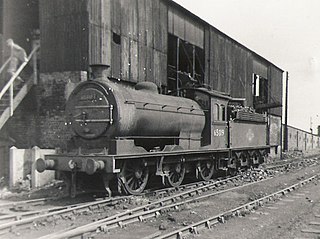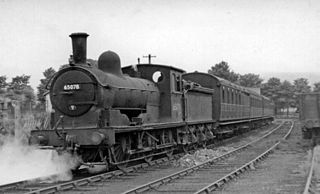The London and North Eastern Railway (LNER) produced several classes of locomotive, mostly to the designs of Nigel Gresley, characterised by a three-cylinder layout with a parallel boiler and round-topped firebox. It produced the most famous locomotive of its day, 4468 'Mallard', the holder of the world steam locomotive speed record. It also built the world-famous 4472 'Flying Scotsman'. However, its locomotive inheritance was much greater than just the 'A4 Class', it also produced highly successful mixed-traffic and freight designs.

The Great Central Railway (GCR) Class 8K 2-8-0 is a class of steam locomotive designed for heavy freight. Introduced in 1911, and designed by John G. Robinson, 126 were built for the GCR prior to the First World War. Including wartime construction for the British Army ROD and the post-war GCR Class 8M, the class and its derivatives totalled 666 locomotives.

The Great Northern Railway (GNR) Small Boiler Class C1 is a class of steam locomotive, the first 4-4-2 or Atlantic type in Great Britain. They were designed by Henry Ivatt in 1897. In total 22 were built between 1898 and 1903 at Doncaster Works. The class were commonly known as 'Klondykes' [sic], after the 1897 Klondike gold rush. They could reach speeds of up to 90 mph. They were also known as Small Atlantics.

Darlington railway works, was established in 1863 by the Stockton and Darlington Railway in the town of Darlington in the north east of England. The main part of the works, the North Road Shops was located on the northeast side of the Stockton and Darlington Railway

The North Eastern Railway (NER) Class P3, classified J27 by the LNER, is a class of 0-6-0 steam locomotive. The P3 Class was designed by Wilson Worsdell and was a relatively minor modification of the existing North Eastern Railway NER Class P2. The most significant change was a deeper firebox with shallower sloping fire grate. This was achieved by raising the boiler slightly, and by reducing the clearance between the firebox and the rear axle. The P3 Class were a freight engine by nature and used for hauling long trains of freight.

The North Eastern Railway (NER) Class C1, was a class of 0-6-0 freight locomotives designed by T.W. Worsdell. They were used throughout the NER system, although particularly in Teesside between 1886 and 1962.

The North Eastern Railway Class T2, classified as Class Q6 by the LNER, is a class of 0-8-0 steam locomotive designed for heavy freight, especially for hauling long coal trains to various collieries in the North Eastern region of the UK, with a maximum speed of 40 miles per hour. One-hundred-and-twenty were built at Darlington Works and Armstrong Whitworth between 1913 and 1921 to the design of Vincent Raven, based on the NER Class T and T1. The batch of fifty built by Armstrong Whitworth from 1919 were A-W's first locomotives to be built, after the conversion of their Scotswood works from ordnance to peacetime production.

The North Eastern Railway Class S3, classified B16 by the LNER, was a class of 4-6-0 steam locomotive designed for mixed traffic work. It was designed by Vincent Raven and introduced in 1920. The earlier members of this class were fitted with Westinghouse Brakes - all of this equipment was removed during the 1930s.

Class EE1 was an electric locomotive commissioned by the North Eastern Railway in 1922. Ownership passed to the London and North Eastern Railway in 1923 and to British Railways in 1948.

The North Eastern Railway (NER) Class H, classified as Class Y7 by the London and North Eastern Railway (LNER) is a class of 0-4-0T steam locomotives designed for shunting.

The North Eastern Railway Class E1, classified as Class J72 by the London and North Eastern Railway (LNER) is a class of small 0-6-0T steam locomotives designed by Wilson Worsdell for shunting. They had inside cylinders and Stephenson valve gear.

The first London and North Eastern Railway (LNER) Class A2 was a class of 4-6-2 steam locomotive designed by Vincent Raven for the North Eastern Railway. Two were built by the NER in 1922 before the grouping and another three by the LNER in 1924. Their LNER numbers were 2400–2404. All five locomotives were named by the LNER.
Matthew Stirling (1856–1931) was Locomotive Superintendent of the Hull & Barnsley Railway (H&BR). Matthew Stirling was born in Kilmarnock on 27 November 1856. He was the son of Patrick Stirling, the nephew of James Stirling, and grandson of Robert Stirling - all of whom were also famous mechanical engineers.

The North Eastern Railway (NER) Class Y 4-6-2T tank locomotives were designed whilst Wilson Worsdell was Chief Mechanical Engineer, but none were built until 1910 by which time Vincent Raven had taken over.
The North Eastern Railway (NER) Class K classified as Class Y8 by the London and North Eastern Railway (LNER) is a class of 0-4-0T steam locomotives designed for shunting. It was designed by Thomas W. Worsdell and five of these tiny engines were built in 1890. These were numbered 559-63.
The NER Class P1 was a class of 0-6-0 steam locomotives of the North Eastern Railway. Class P1 was a development of Class P, having a boiler four inches longer, and a firebox six inches longer. To accommodate these, the wheelbase was increased by nine inches. The cylinder stroke was also increased by two inches. None survived into preservation

The GER Class M15 was a class of 160 2-4-2T steam locomotives designed by Thomas William Worsdell and built for the Great Eastern Railway between 1884 and 1909. The original (F4) class of locomotives were fitted with Joy valve gear which was notoriously difficult to 'set'. This earned them the nickname of 'Gobblers' thanks to their high coal consumption rates. As a result, between 1911 and 1920, 32 of them were rebuilt by James Holden with Stephenson valve gear and higher pressure boilers. Despite this, the nickname stuck for many years after.

The NBR S Class is a class of 0-6-0 steam locomotive designed by William Paton Reid for freight work on the North British Railway. The engines were initially designated as B class, being a development of the standard B class locomotives designed by Reid some eight years previously, and represented the culmination of a long evolution on the NBR of powerful 0-6-0 freight engines. The new locomotives were introduced in 1914 and had superheaters, inside cylinders and piston valves operated by Stephenson valve gear.

The GCR Class 9J was a class of 174 0-6-0 steam locomotives designed by John G. Robinson for freight work on the Great Central Railway (GCR) in 1901.

The NER Class R1 was a class of 4-4-0 steam locomotives of the North Eastern Railway. The class was designed by Wilson Worsdell and built from 1908 to 1909.
















